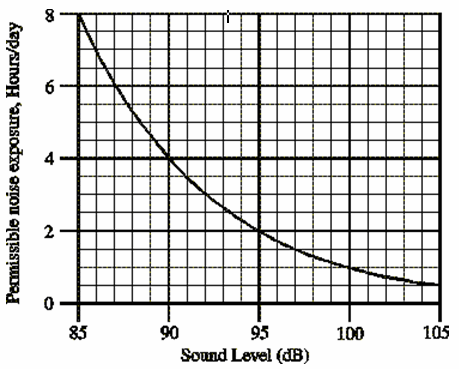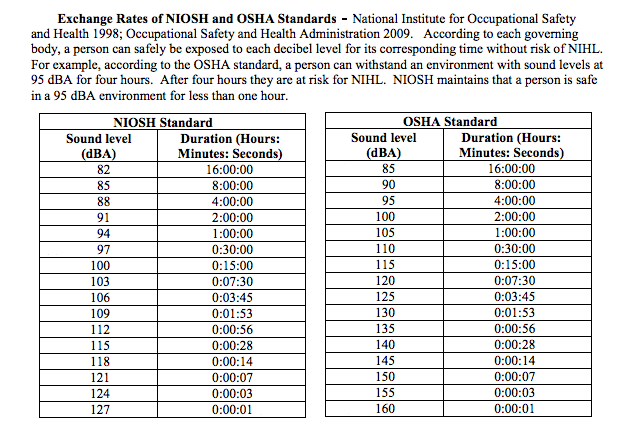

| Deutsche Version |
| Sound Pressure Level (SPL) and Permissible Exposure Time for Noise Guidelines for Level and Duration (Time) − Not only the permissable Sound Level − Question: How long can a person endure a certain noise level before hearing impairment occurs? |
| Sound Pressure Level | Sound pressure | Permissible Exposure Time |
| 115 dB | 11.2 Pa | 0.46875 minutes (~30 sec) |
| 112 dB | 7.96 Pa | 0.9375 minutes (~1 min) |
| 109 dB | 5.64 Pa | 1.875 minutes (< 2 min) |
| 106 dB | 3.99 Pa | 3.75 minutes (< 4 min) |
| 103 dB | 2.83 Pa | 7.5 minutes |
| 100 dB | 2.00 Pa | 15 minutes |
| 97 dB | 1.42 Pa | 30 minutes |
| 94 dB − − − − − − − − − − | 1.00 Pa − − − − − − | 1 hour − − − − − − − − − − − − − − |
| 91 dB | 0.71 Pa | 2 hours |
| 88 dB | 0.50 Pa | 4 hours |
| 85 dB | 0.36 Pa | 8 hours |
| 82 dB | 0.25 Pa | 16 hours |
| Guidelines for recommended permissible exposure time for continuous time weighted
average noise, according to NIOSH-AINSI and CDC. For every 3 dB sound pressure level (SPL) over 85 dB, the permissible exposure time is cut in half − before damage to our hearing can occur. NIOSH = National Institute for Occupational Safety and Health and CDC = Centers for Disease Control and Prevention. OSHA = Occupational Safety and Health Administration. This may not represent a worldwide view of the subject. Noise is an increasing public health problem and can have the following adverse health effects: hearing loss, sleep disturbances, cardiovascular and psychophysiological problems, performance reduction, annoyance responses, and adverse social behaviour. A person feels and judges sound events by exposure time, spectral composition, temporal structure, sound level, information content and subjective mental attitude. |
To determine SPL and exposure time
| Simply enter the value to the left or the right side. The calculator works in both directions of the ↔ sign. |
| You can never measure the sound pressure level accurately
as it will always change: albeit a little. Potentially hazardous
SPL cannot be determined just to the moment before hearing
impairment occurs, as it typically depends upon the person
listening. Sensitivity among individuals will vary. Maximum exposure time (hr): D = 2((94−SPL)/3) Maximum exposure time (min): D = 480 / 2((94−SPL)/3) Sound pressure level SPL = 10 × log (D/100) + 85 D = duration of the permissible noise. |
 |
| Compare the Different Standards of NIOSH und OSHA |

| NIOSH represents the use of an 8-hour exposure of noise at 85 dBA and a 3 dBA doubling rate,
to determine the noise dose. OSHA represents the use of an 8-hour exposure of noise at 90 dBA and a 5 dBA doubling rate, which does not protect persons from hearing loss over their whole working lifetime. The answer to the question whether NIOSH or OSHA have more "correct" decibel values, may depend on the different perspective of the employer and the employee. Noise protection always costs money. |
| Table of Sound Levels (dB Scale) - Sound Pressure and Sound Intensity |
| Warnings: Earbuds and intra-aural transducers can result in sustained high volume levels that causes irreversible damage to the inner ear because of the high sound pressure which is fed directly into the sensitive ear canal. Users of MP3 players usually listen to music through headphones louder than at home with the stereo equipment, because it is more difficult with headphones to estimate the adequate volume. Additionally, often the sound is also just turned up to cover unwanted ambient noise. |
| Sound pressure and Sound power − Effect and Cause |
| Acousticians and sound protectors ("noise fighters") need the sound intensity (acoustic intensity) – but sound engineers and sound designers ("ear people") don't need that sound energy quantity. Who is involved in audio engineering, should rather take care of the sound field quantity, that is the sound pressure or the sound pressure level (SPL) as an effect at the eardrums of our hearing and on the diaphragms of the microphones, and the corresponding audio voltage and its voltage level. |
| The sound pressure is the force F (N) of sound on a surface area A (m2) perpendicular to the direction of the sound. The SI-units for the sound pressure p is N/m2 or Pa. |
| next |
Search Engine |
home |